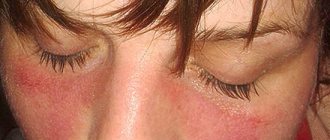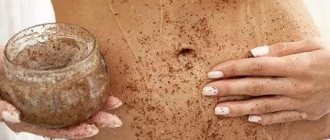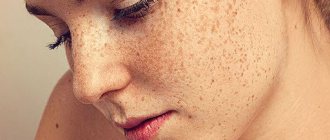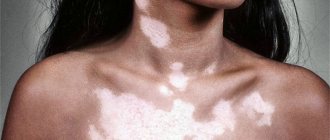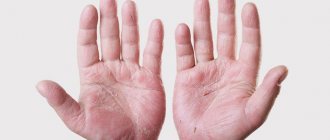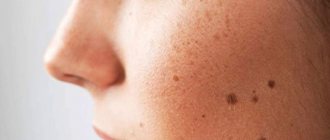Causes of age spots
(also called chloasma) arise for various reasons. The most common are hormonal changes
, the purpose of which is to prepare a woman for childbirth.
As a result, the distribution system of pigments, in particular melanin,
responsible for skin color.
Moreover, there are 3 types of it at once
, the combination of which determines your skin tone:
eumelanin
is responsible for black,
phacomelanin
for brown and
pheomelanin
for yellow.
During pregnancy, the amount in the blood of the hormone that ensures the synthesis of these pigments does not increase, but the sensitivity of certain areas of the skin to the effects of female sex hormones changes
, namely estrogens (their concentration during pregnancy, on the contrary, increases significantly), which cause the uneven distribution of melanin in the skin.
As a result, it accumulates locally (in melanocytes - special skin cells) and pigment spots are formed
.
also an opinion
that the appearance of age spots may be due to a deficiency of vitamins B and C, iron, zinc, copper; severe stress or genetic predisposition.
Another catalyst for the awakening of chloasma may be the time of year.
: Usually from late spring to late summer, the risk of age spots on a pregnant woman’s body increases due to exposure to ultraviolet rays on the skin.
In addition, scientists have noticed that, as a rule, those with dark skin
. However, the fact that your skin is as white as snow does not give you 100 percent protection from age spots, you will simply be less likely to experience them.
Unfortunately, among these completely harmless reasons, more serious ones may be hidden.
: liver or adrenal gland diseases, gynecological diseases, or thyroid problems.
Therefore, when spots appear
Be sure to consult your doctor for advice.
In which areas of the skin does hyperpigmentation most often appear?
In fact, pigment spots can appear on any part of a woman’s body.
, however, there are also the most “popular”.
These include: forehead, nose, cheekbones, cheeks, upper lip, chin, shoulders, arms, back, décolleté, nipples, abdomen, labia and places where clothing is most closely attached to the body.
In this case, chloasma can appear very suddenly without being tied to a specific trimester. Fortunately, there are many women who avoided this unpleasant fate and went through the entire nine months without a single pigment spot.
Description
Dermatologists call this disease chloasma, melasma or “mask of pregnancy.” Brown, symmetrical spots on the skin of the face and neck appear more often in women with dark skin after sun exposure. The edges are uneven, clearly defined, without signs of inflammation. The color varies from barely noticeable light brown to a deep dark, almost black shade. It develops gradually, most often in the second and third trimester of pregnancy. The forehead, cheeks, upper lip and chin are most often affected, but sometimes pigmentation covers the areola of the nipple, labia, abdomen, back, and limbs.
This condition can appear when the hormonal status in men is changed for some reason (disease of the pituitary gland, adrenal glands, gonads). Sometimes it occurs as a side effect of taking oral contraceptives or other steroid drugs.
Usually, after pregnancy, pigmentation slowly fades and completely disappears within a few months, leaving no traces of its existence. Its occurrence can be prevented by limiting the time spent in the sun, wearing a wide-brimmed hat, avoiding tanning in a solarium, and regularly applying sunscreen to the skin.
What to do if you find age spots on your body?
First of all, don't panic
. The only problem that occurs on the body of pregnant women along with chloasma is its unaesthetic appearance.
And fortunately, with the restoration of hormonal levels after the birth of a child and the onset of the first menstruation, women, as a rule, return to their natural skin color.
In the meantime, we advise you not to use special bleaching agents against hyperpigmentation under any circumstances.
, since most of the active substances they contain are extremely toxic to the unborn baby and can have a negative impact on the quality of breast milk.
However, you shouldn’t leave the house for months because of your “spotting”, because you can use natural remedies
, for example, masks based on sweet pepper, cucumber, cabbage, red currant or parsley.
So, to eliminate excess pigment, you can lubricate hyperpigmented areas of the skin every evening with a cotton swab dipped in healing juice or decoction.
For skin tone
You can freeze juice from the above-mentioned vegetables or fruits in ice trays, and then wipe your face with these ice cubes.
But whatever method you choose, remember that these procedures should be performed in the evening
so as not to expose your skin to the sun afterwards.
Traditional recipes, of course, will not provide you with instant results, but it is quite possible to even out your skin tone a little with their help.
If you need to go out urgently and there is absolutely not enough time to wait for the mask to take effect, you can use decorative cosmetics
. But let us remind you that it is necessary to choose only the highest quality and natural products, since everything that the mother’s skin absorbs also reaches the baby.
Age spots after pregnancy
As mentioned above, usually pigment spots gradually disappear
. But it also happens that they can stay with you for many years or bother you every year with the arrival of spring.
In this case, every year at the end of February - beginning of March you will need to provide yourself with protection from the sun's rays
. To do this, apply sunscreen with an SPF factor of 30 or more to visible areas of the skin.
However, remember that their effect ends after approximately 4 hours, and if you are going to spend more time outdoors, take the cream with you so that you have the opportunity to remove the previous layer and apply a new one.
Do not forget that from 11.00 to 17.00 it is better to refrain from walking
, since at this time the sun is most active.
But with hyperpigmentation, even in the early morning or evening, it is best to sunbathe in the shade
to avoid direct sunlight on the skin, because under their influence the intensity and size of the spots can increase significantly.
In addition, it would be a good idea to contact a dermatologist.
, which will definitely help you solve your problem.
But no matter how the circumstances develop, regardless of the number and intensity of your “freckles”, love yourself this way. After all, hyperpigmentation is the protection of your body from the effects of ultraviolet radiation, and if it appears, it means that right now your body needs this defense.
Moreover, at this time you are responsible not only for yourself, but also for your future baby. Nature, in turn, thus tries to save you from possible troubles
.
With the restless passage of time, our skin pleases us less and less: every now and then a new, treacherously noticeable wrinkle “pops up”. But these are not the only metamorphoses that await a woman’s face (and body) with age. Pigment spots are another skin defect that can completely ruin anyone’s mood.
To keep your facial skin young and girlishly clean for as long as possible, experts exhort: don’t be lazy in taking care of yourself from a young age! However, there is a large group of women who are at risk of increased pigmentation development more than others. These are future mothers. Are age spots dangerous during pregnancy and the most effective ways to combat them? We will discuss below.
Cheerful women try to see something positive and useful in any trouble. For example, by the number of dark spots on the skin, pregnant women calculate who is lurking in their belly for the time being - a boy or a girl? There is an opinion that girls “steal” their mother’s beauty and become the cause of increased pigmentation. From a scientific point of view, this phenomenon can be explained by the increased need of a female child for the mother’s sex hormones. The pregnant woman pays for the sharp decrease in the level of these specific substances with her own attractiveness in the form of puffiness, acne and age spots on the face.
When age spots appear on the face during pregnancy
Pregnancy has been and will be the most unpredictable period in a woman’s life. So much happens over the course of 9 long months: your breasts rapidly become fuller and your belly enlarges, toxicosis alone is worth it! In addition, some women, while expecting a baby, are forced to sadly admit the fact that an “interesting” position does not add extra attractiveness, except that spiritual beauty increases. Who would like a scattering of clearly visible dark spots on the skin? And it’s good that such a “surprise” was found on the body, and not on the face, although the forehead and cheeks are favorite places for age spots while waiting for an heir.
The first pigmentation marks the beginning of pregnancy: the nipples and areolas on the breasts, the area around the genitals, the labia and the clitoris become noticeably darker at the earliest stage of gestation. Expectant mothers perceive such changes with interest rather than concern. The situation changes dramatically when the skin of the armpits, certain areas of the neck and face rapidly darken - what is happening to me, is it harmful, how can I get rid of such “beauty”? The excitement of women can be understood: with each new day of pregnancy, they become more and more aware of the significance of their situation, and begin to think more and more about themselves and about the health of their child.
Nature is inexorable, and the peak of coloration of the skin in pigment “patterns” occurs in the second trimester, and individual pigment spots can appear on the skin right up to childbirth. This is not news for doctors: at a doctor’s appointment, an expectant mother may hear a new concept for herself - chloasma of pregnancy, or, as it is most often called, “the mask of pregnancy.” The spots appear indiscriminately on the skin, but the most common places where pigmentation is concentrated are the cheeks, nose, forehead, cheekbones, skin under the eyes, above the upper lip, and chin. Sometimes arranged symmetrically, abstract spots form the most incredible patterns and shapes - flower petals, a heart, butterfly wings, drops.
No less often, the skin darkens in places of regular contact with clothing: on the inner thighs and armpits. In almost all pregnant women, a dark vertical stripe in the center of the rounded belly divides it into two equal parts. The décolleté area, back and hands are also “favorite” places for pigment spots to appear during pregnancy (photo):
Localization of skin rash during pregnancy
The location of the rash can indicate the nature of the skin lesion and help determine which disease the rash is a symptom of.
A rash can form:
Instructions for use of Uniderm cream and ointment
- On the stomach and arms;
- On foot;
- On the face;
- Around eyes;
- In the mouth.
Rash on legs and stomach
The main causes of rashes on the legs: allergies, dermatosis and infections. But the most dangerous diseases during pregnancy, accompanied by a rash, cover the entire body. Measles and rubella first affect the skin of the face, and with chickenpox, blisters immediately appear all over the body.
A small rash on the stomach or arms, including blisters, is most often evidence of hormonal changes caused by pregnancy. In this case, the rash may also appear on other parts of the body, including the thighs and chest. Also, a rash on the stomach can be caused by an allergy to household chemicals, foods, cosmetics, etc.
The third common cause of belly rash is heat rash. It is accompanied by blisters that do not cause itching. Miliaria most often appears in the summer, as well as in women wearing synthetic fabrics and bandages.
Important! A skin rash on the abdomen may indicate an infection or pathology of the internal organs. You should consult a doctor immediately if the rash is accompanied by weakness, fever, pain or itching in the affected area. Also, the doctor needs to show a rash that does not go away and gets worse for more than 3-4 days.
Causes of rash on face
A rash often appears on the face during pregnancy, resembling subcutaneous acne. The rash appears on the nose, chin or forehead. Redness and small pimples do not pose a danger to pregnancy and are caused by hormonal changes. Blistering rashes around the eyes, accompanied by inflammation, are often caused by demodicosis. This disease is caused by the iron tick. The parasite is found in the eyelid glands, hair follicles, and sebaceous glands of the skin. The disease requires urgent medical attention, although it does not pose a danger to the fetus.
Rashes on the oral mucosa and tongue are most often caused by stomatitis; if there is no high temperature, you should consult a dentist. If you develop a fever or a similar rash on your body, you should consult a physician. Rashes that appear in the mouth and on the skin are most often caused by infections, including herpes, chickenpox, measles, and rubella.
Causes of a cosmetic defect
In truth, hormone deficiency is not the only cause of the defect. There are other factors that can cause pigment spots to appear during pregnancy.
The first and most important point in this whole “spotty” story is the concentration of melanin in the skin of every person, inherent in nature. This coloring pigment accumulates in specific molecules, which science has dubbed melanosomes. Their main task is to protect the upper skin from contact with aggressive ultraviolet radiation. The higher the melanin content in the skin, the darker it is, and the higher the risk of pigment spots appearing on it.
The completed conception becomes a trigger for hormonal changes, which makes adjustments to the process of synthesis and accumulation of dye in the skin. This is taken care of by the adrenal glands, which begin to diligently produce estrogens, progesterone and melanocyte-stimulating hormone. As a result, the level of melanin in the skin increases significantly. Excessive amounts of pigment are concentrated in the most unexpected places for the expectant mother on the face and body.
An increased concentration of the dye causes the development of hyperpigmentation. This is exactly what a pregnant woman encounters when she watches with horror the rapidly darkening skin on certain areas of the back, neck, chest and face. As we have already noted, hyperpigmentation becomes especially widespread at the beginning of the second trimester and slows down slightly in the later stages of pregnancy.
Note that a sharp increase in the level of melanin in the skin can be dictated not only by the natural laws of physiology, but also by other reasons:
- the appearance of dark spots on the skin is sometimes a consequence of long-term use of oral and antiepileptic drugs before pregnancy;
- in some cases, hyperpigmentation will indicate to the specialist a lack of folic acid in the body of the expectant mother;
- increased pigmentation makes itself felt in liver function disorders, pituitary diseases, ovarian pathologies, excessive use of perfumes and decorative cosmetics of dubious quality;
- A “spotty” skin color in a pregnant woman is highly likely to appear after prolonged contact with ultraviolet radiation. It’s not for nothing that freckled people (and freckles are the most common age spots) are called sun-kissed;
- Most often, hyperpigmentation is a hereditary factor.
When do pigment spots go away after pregnancy?
The most pleasant thing for an expectant mother who is concerned about the manifestation of pigmentation on the skin will be the news that the scattering of dark spots on the face after childbirth will first turn pale and then completely disappear. Indeed, many of the nuances of appearance acquired during pregnancy are temporary phenomena. The extra pounds will go away, your abs will appear again, swelling in your legs and puffiness on your face will disappear, and your hormones will finally calm down. The same applies to hyperpigmentation: the skin will clear up 3 or even 2 months after the woman becomes a happy mother.
Do not be upset if individual dark spots linger for a longer period: pigmentation can persist for several years. Eventually she too will become much paler. In addition, with the support of modern cosmetology and traditional medicine, you can improve the condition of your skin both after childbirth and during pregnancy.
Methods of disposal
Having decided to get rid of chloasma, it is important to remember that during pregnancy most cosmetic products are unacceptable, as they can do more harm than good. First of all, you should think about the baby’s health, and then about your attractiveness. The best time for such cosmetic procedures is the period after the birth of the baby.
Let's consider several folk remedies that soften the intensity of chloasma, or even completely eliminate the “mask of pregnant women.”
Everyday precautions:
- Calmness and only calmness will protect the expectant mother not only from stress, but also from hyperpigmentation.
- A wide-brimmed hat and light, light-colored clothing that covers the skin will protect against the harmful effects of ultraviolet radiation, which can cause spots on the face.
- Exposed areas of skin should be covered with special sunscreens when going for a walk in the spring and summer.
- Eating foods rich in vitamins, minerals and folic acid. These products include: fish, liver, beef, green salad, cabbage, cranberries, currants, dill and parsley, sweet peppers, etc.;
- Refusal from chemical-rich decorative cosmetics during pregnancy.
- Taking care of your health, constant and rigorous. Even before pregnancy, it is important to treat all problem areas of your body, then during the “interesting period” there will be fewer “side effects”.
These methods are available to everyone and have rather preventive purposes. Now let's talk about more effective methods, which must be resorted to after the problem appears.
How to get rid of age spots during pregnancy
From the point of view of clinical medicine, it makes no sense to conduct a targeted fight against age spots during pregnancy, since they do not pose any threat to either the mother or her child, and disappear some time after childbirth. However, women always want to be beautiful and are not going to make any compromises - today there are countless recipes that will help lighten the skin and make age spots less noticeable.
Facial wipes
There is no more generous giver than nature. For example, fruit acid can transform the skin beyond recognition!
- Lemon juice occupies a leading position in the list of natural skin bleaching agents. The expectant mother can see this for herself: squeeze the juice out of a large slice of citrus, add water to it in a ratio of 1 to 5 and put it in the refrigerator. The brightening agent should be used regularly, wiping the face with a cotton swab soaked in the solution in the morning and evening. It will take several months to achieve a visible effect, but the result is worth it: the skin will acquire a lighter tone, and pigmented rashes will decrease.
- Shock freezing of forest and garden berries is an excellent opportunity to indulge your gastronomic cravings even in the cold season. These gifts of nature will also benefit your skin. Simply mash a couple of lingonberries, raspberries, cranberries or strawberries and cover your face with this paste. If you make this cosmetic procedure a habit, your skin will eventually become clearer by a few pigment spots.
- The price of pharmaceutical castor oil will suit any wallet, and the composition will suit the taste of skin speckled with pigmentation spots. To get rid of the defect, you need to wipe the areas of greatest accumulation of spots on your face and body with a piece of cotton wool soaked in castor oil in the morning and evening. Healthy skin is not affected.
- Let us share with you another effective recipe made from pharmaceutical ingredients for removing unattractive age spots. You need to mix 1 tsp. 30% hydrogen peroxide, 2 tsp. boric alcohol and 1 tsp. glycerin. Wipe your face with the prepared product once a day until a noticeable whitening effect appears.
Lotions for pigment spots
One of the most effective ways to remove age spots from the face at home is considered to be lotions. It is enough to apply them once a day before bed for 2 weeks.
- 1 tbsp. l. combine fresh lemon juice with 2 tbsp. l. honey Cover your face with a gauze cloth soaked in the product and rest for 20 minutes, then wash with warm water.
- Soak gauze in yogurt, apply to the areas of greatest concentration of age spots on the face, then rinse off the remaining dairy product with warm water.
- Mash 5 tbsp. l. fresh red currants until pureed, then transfer the mixture into a thermos and pour a glass of boiling water over it. The product will need 3 hours to infuse. Cool the finished berry infusion, strain and pour into a glass container. Soak a gauze pad in the solution and apply a lotion to age spots for 20 minutes. After the procedure, wash your face with warm water and lubricate your face with moisturizer.
Masks to improve the appearance of facial skin
- Dissolve a spoonful of starch in lemon juice to the consistency of thick sour cream. Apply the mixture all over your face and leave for 15 minutes, then rinse with clean water and apply a nourishing product. Make a mask twice a week.
- Peel a medium-sized cucumber and grate the vegetable on a fine grater. Pour enough oatmeal into this mixture to make a not very thick mask. Apply the product to your face and after 20 minutes, wash with cool water. The mask can be done up to 3 times a week.
- Combine equal parts of liquid honey, lemon vinegar and table vinegar and mix them until a homogeneous mixture is obtained. Before using the mask, steam your face, then apply the mixture to the skin in an even layer and leave for 25 minutes. To remove the mask you will need a large amount of warm water. The whitening effect of this procedure will not take long to appear.
- Grind a bunch of fresh parsley in a blender and cover the pigmented skin of your face with the resulting paste. Leave the mask on for half an hour, then wash with cool water and lubricate your face with nourishing cream.
When planning to categorically fight back against age spots on the face and body, the expectant mother should remember that some ingredients in homemade cosmetics (for example, honey, strawberries) can provoke the development of an allergic reaction, so they need to be used wisely.
How to remove pigmentation after childbirth?
There are many medicines and cosmetics that remove age spots on the face after pregnancy. Ideally, such a drug should be prescribed by a cosmetologist or dermatologist. Some products have contraindications.
Local cosmetic preparations that help remove age spots:
- Skinoren is an effective and popular remedy. Has many positive reviews from satisfied women. It has brightening properties and does not contain toxic components. The advantage is that the active substances affect only the spot, but not the healthy skin;
- Retin A helps reduce the concentration of melanin in the skin. It must be applied once a day. Leave on the skin for six hours, then wash off with warm water. To remove spots from your face you need to use it for a month or more;
- Achromin ointment is characterized by dual therapeutic properties. It not only reduces the melanin content in the spot, causing it to go away, but also protects the skin from ultraviolet exposure;
- Union line of products with a brightening effect. The kit includes serum, gel and cream. To get rid of age spots after childbirth, three drugs must be applied to the face in a certain order. The products contain a substance such as hydroquinone, which inhibits the synthesis of melanin. The brightening property is provided by ascorbic and glycolic acid.
It is worth knowing: during lactation, it is strictly forbidden to use medications to remove age spots, which include salicylic acid, hydroquinone, and tretionin.
How to prevent age spots on your face during pregnancy
- These recommendations, most likely, will not save a pregnant woman from all dark spots (hormones that we cannot control are involved in this matter, remember?), but they will definitely help reduce their number several times. From noon to 6 pm you should not be in direct sunlight - this is the most dangerous period of the day for ultraviolet-sensitive skin. For the same reason, you need to use cosmetics with a high level of sun protection.
- Cosmetics in a pregnant woman’s arsenal should be proven and of high quality.
- The expectant mother should ensure that no chemicals come into contact with her skin.
- Regularly taking multivitamins as recommended by your doctor is the key to a good mood and great appearance.
- The food that a pregnant woman eats will certainly be “tasted” by her baby. Therefore, during the entire 9 months of waiting, healthy foods should predominate in a woman’s diet: vegetables, fruits, cereals, liver, fish, vegetable oils.
What to do if pigmentation remains after childbirth
In 98 cases out of 100, all pigment spots that appeared during pregnancy disappear 2 to 3 months after birth. But if after 10 - 2 months the dark areas of the skin stubbornly do not want to leave the woman’s face or body, you can seek advice from doctors. A dermatologist, gynecologist or therapist will help with this issue. Consultation with a competent specialist will help you find out whether age spots are the result of any disease not related to pregnancy.
If the remaining pigmentation is not a consequence of the disease, salon procedures in the form of medicinal cosmetics or laser will help clear the skin of unattractive spots.
What to do?
For each cause of spots on the face and body, appropriate treatment is prescribed. The following algorithm of actions for a pregnant woman can be formulated:
- If you find hyperpigmentation on your face or body, it does not require special treatment and goes away on its own. You can use topical products to reduce the appearance of the spots. Do not use traditional recipes if you are hypersensitive to their components.
- Prevent stretch marks during pregnancy. At the first sign of stretch marks, apply topical products to the affected area of skin.
- Red spots should be a reason to consult a dermatologist. Don't forget to tell your doctor about your pregnancy so that you can choose the right treatment.
- Follow the recommendations of a specialist (dermatologist and gynecologist) for a speedy recovery.
- If you have a pinpoint red rash of a generalized nature, a visit to the doctor cannot be postponed.
Simple rules will help maintain health and beauty during pregnancy.
Ways to eliminate pigment spots. Video
Many women, while expecting a baby, are faced with such an unpleasant phenomenon as pigment spots during pregnancy. This cosmetic defect is also known under the names “chloasma”, “melasma”, as well as hyperpigmentation of the skin. Pigmentation during pregnancy manifests itself in the form of spots of various shades of brown (sometimes red), which are located on the nasolabial triangle, chest, along the abdomen, forehead, neck, and sometimes even on the back. What causes skin pigmentation during pregnancy? Let's try to figure it out.
Types of pigmentation during pregnancy
Pigmentation during pregnancy can manifest itself in a variety of ways. For example, in ladies with fair skin, the spots are likely to be quite pale and insignificant. But those with dark skin are a little unlucky: their “pregnant mask” looks much brighter and richer.
Pigmentation on the abdomen
during pregnancy, it is a brown stripe that stretches from the pubis to the navel (it is also called “Alba’s line.” Mostly this vertical stripe appears on the abdomen in the second trimester.
Breast pigmentation can cause a lot of aesthetic discomfort.
during pregnancy, as well as spots on the face that are regular or irregular in shape. As a rule, the size and shape of the spots is determined by individual factors.
Pigmentation of the nipples is also considered common.
during pregnancy. Their color changes from pink to dark brown. It is believed that the darker color of the nipples after childbirth helps the baby quickly find the breast to satisfy his hunger.
By the way, don’t worry that the spots on your body will remain after childbirth. A woman’s body functions in such a way that pigmentation disappears very quickly after pregnancy. Just 4-5 months after giving birth, not the slightest trace remains of the unsightly brown spots.
Diseases that cause rash during pregnancy
Skin rashes during pregnancy can be caused by various diseases, some of which can harm the fetus:
- Dermatosis. Most often, the appearance of a rash on the body during pregnancy is associated with hormonal changes in a woman’s body. Hormonal levels always affect the condition of the skin. So, even before pregnancy, a woman may notice a rash on her face and body before or during her period. Symptoms of dermatosis during pregnancy are plaque or nodular rashes in the area of stretch marks on the thighs or abdomen, on the back, and chest. Such rashes on the body during pregnancy due to changes in hormonal levels are quite normal, but only if the rash is not widespread, small and does not cause pain or itching. Pimples usually disappear after childbirth and do not cause any harm to the baby.
Important information! It is necessary to consult a doctor if the rashes merge, forming large skin lesions, have an unpleasant odor, hurt, or itch. A dermatologist can select products that will relieve discomfort.
- Hives. This disease can occur due to nervousness, due to allergies. The rash looks like a nettle burn. Urticaria requires medical supervision, but does not pose a danger to the fetus.
- Scabies. This disease is accompanied by the appearance of tubercles and bubbles on the code. Most often, rashes appear between the fingers and toes. The affected areas of the skin are very itchy. However, scabies does not pose a danger to the baby, and the mother can receive prompt treatment.
- Rubella. This is a viral disease dangerous to the fetus. Symptoms of the disease: pale pink rash, fever, headache, nausea. The rubella virus in a pregnant woman has a detrimental effect on the fetus in the first trimester. During this period, rubella causes cataracts, heart defects, deafness, and damage to the nervous system.
Important! Pregnancy must be terminated if rubella is detected in the first trimester.
- Allergy. During pregnancy, allergies often develop, including to foods or substances that previously did not cause a negative reaction in the body. An allergic rash may appear as small red itchy spots, blisters with clear liquid, or large red spots.
- Genital or herpes zoster. If a primary infection with genital herpes occurs during pregnancy, the risk of infection of the fetus is 50%. If an exacerbation of an existing disease occurs during pregnancy, the risk is reduced to 4%. When the disease occurs, blisters with clear liquid and small red rashes appear. In this case, skin lesions are accompanied by itching and burning. Skin blisters burst over time, leaving ulcers in their place. Herpes suffered in the first trimester can provoke the development of cardiovascular pathologies and the development of dementia. In the third trimester, herpes threatens with hepatitis, pneumonia, and encephalitis.
- Measles. A viral disease develops in people who have not received the vaccine. In the first trimester, the disease causes nervous system pathologies in the fetus, including dementia. Measles manifests itself as skin rashes in the form of tubercles; a rash first appears on the face, which then spreads to the torso, arms, and legs.
Important! Measles infection in the first trimester causes termination of pregnancy.
- Simple herpes. Usually the focus of the disease appears on the lips and nose; with proper treatment, the virus does not harm the mother and fetus. The risks are high only if the mother is initially infected in the first months after conception. An exacerbation of the disease or infection with a virus after 20 weeks of pregnancy can no longer harm the fetus, since it is protected by the developed placenta. However, herpes simplex in any case requires quick and proper treatment.
- Chicken pox. The disease is provoked by a virus, the onset of the disease manifests itself in the form of pink spots followed by the formation of small blisters with a clear liquid. The rash affects the face, mucous membranes, and body. Dried blisters become crusty. The disease causes severe skin itching and a sharp increase in temperature in the first days of the disease. Chickenpox in pregnant women is a very dangerous disease. In the last and first trimester, the disease increases the risk of fetal pathology, miscarriage or premature birth.
Note! In the last trimester, chickenpox is dangerous due to oxygen deprivation, intrauterine infection, and pneumonia.
- Allergy. An allergic rash on the body and face during pregnancy looks like small blisters with transparent contents or red spots spreading throughout the body. An allergic reaction cannot harm the baby unless it makes it difficult for the mother to breathe.
- Prickly heat. During pregnancy, a woman spends a lot of time sleeping, and she also sweats more. Therefore, a rash on the face during pregnancy can cause excess moisture on the skin, which causes irritation. If prickly heat is not of fungal or bacterial origin, then the rash does not require drug treatment. If you have heat rash during pregnancy, you need to pay more attention to personal hygiene, wear loose and light clothing, and sleep on fresh bedding made of cotton or calico.
Age spots during pregnancy: is it possible to avoid them?
If there are concerns that pigmentation may occur during pregnancy or that it has already appeared, then you should use the following tips. With their help, it will be possible to prevent such an unpleasant phenomenon, as well as somewhat minimize it.
Firstly, it is recommended to organize a nutritious diet, which includes:
- Mandatory presence in the diet of oranges and liver dishes, which contain a significant amount of folic acid necessary for the pregnant body;
- Avoid heavy and fatty foods, the consumption of which significantly increases the load on the liver, which leads to the appearance of age spots;
- Including fish dishes, cereals, fruits, light meats, and greens in the diet. It is advisable to steam all dishes to preserve their beneficial properties as much as possible;
- Reducing the consumption of salt, sugar, coffee and strong tea.
Secondly, it is strongly recommended that a pregnant woman spend more time in the fresh air, do gymnastics, etc. An active and healthy lifestyle has a beneficial effect on the normalization of metabolism, hormonal levels and helps eliminate toxins. Consequently, pigment spots during pregnancy may not appear at all or may fade significantly.
Thirdly, if there are spots on the chest during pregnancy or on other parts of the body, then you can use folk remedies to reduce their intensity.
When do spots go away on their own?
In many cases, pigmented areas on the skin go away on their own, after several months (usually up to a year), when the hormonal levels have completely stabilized. Breastfeeding can delay the process for a longer period. At first the spots fade, and later disappear completely. Some spots do not go away so quickly and can accompany their owner for several years. But don't despair. A modern set of traditional medicine recipes, ready-made pharmaceutical and cosmetic products, and modern cosmetology products will help remove age spots in a shorter period of time.
Folk remedies to combat pigmentation during pregnancy
- Using natural whitening agents, which include strawberries, cucumbers, and fresh parsley. You can squeeze the juice out of them and then wipe the desired area of the body with it (you need to let it dry, do not wash it off). Due to the high intensity of the effects of parsley, it can be left on the body for no more than 10 minutes;
- Kefir, sour cream, cottage cheese and yogurt have proven themselves to be excellent whitening agents. They should be applied to the problem area for 15 minutes, then rinsed with boiled water. After this procedure, red spots during pregnancy usually lose their saturation;
- For the face, you can make a lotion from lemon (juice of one fruit) and honey (2 tablespoons). It is recommended to keep the mixture placed on gauze for 20 minutes, then wash thoroughly;
- A decoction of elderberry, celandine and parsley can also be applied to problem areas;
- It is advisable to limit the time spent in direct sunlight. When going out in the sun, you should use hypoallergenic sunscreens with a protection factor of 15 or higher (the best option is cosmetics for children).
